
Keeping pests on the run can keep growers hopping. But a good integrated
pest management program will tip the balance in the growers’ favour,
and the heart of any IPM strategy is effective crop scouting.
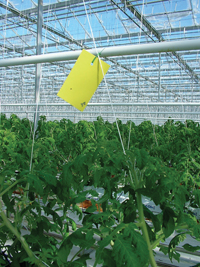 |
|
| Sticky cards are essential scouting tools PHOTO COURTESY MGS HORTICULTURAL INC. |
|
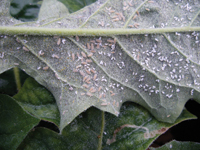 |
|
| Monitoring ratio of delphastus to whitefly PHOTO COURTESY KOPPERT CANADA |
|
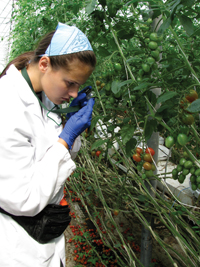 |
|
| Aggie Fehr of Crop Defenders examines the parasitism of Encarsia on whitefly nymphs in a tomato crop. PHOTO COURTESY CROP DEFENDERS |
|
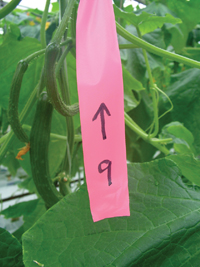 |
|
| Alerting greenhouse staff that there are infested plants in this row. PHOTO COURTESY MGS HORTICULTURAL INC. |
|
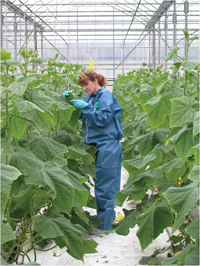 |
|
| Anna Boldt, a Koppert scout, takes notes while checking a plant. PHOTO COURTESY KOPPERT CANADA |
|
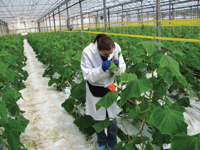 |
|
| Nicole Stewart of Crop Defenders looks at the start of spider mite infestation in a young cucumber crop. PHOTO COURTESY CROP DEFENDERS Advertisement
|
Keeping pests on the run can keep growers hopping. But a good integrated pest management program will tip the balance in the growers’ favour, and the heart of any IPM strategy is effective crop scouting.
Scouting is either done in-house or by contracted commercial specialists. Whatever the choice, the experts emphasize you need to be fully committed to scouting throughout the crop cycle … no ifs, ands or “bugs.”
Attention to detail and good record-keeping are a few of the traits that make a good crop scout. Not everyone can do it. But whether it’s done in-house or by a commercial company, it easily pays for itself several times over in reduced crop losses and improved yields and quality, say the experts.
In the war on pests, it’s the crop scout that sounds the alarm. The earlier the problem is detected and the quicker the IPM response, the better the chance for success.
IPM SUCCESS: IT ALL REVOLVES AROUND EFFECTIVE SCOUTING
■ “IPM programs won’t work without good scouting, whether it’s done in-house or by a third party,” notes Kevin Cullum, national sales and technical manager with Koppert Canada.
Dr. Ishtiaq Rao, scientist and business manager with Crop Defenders Ltd., agrees. Many growers may feel their employees will let them know if they find problems – disease, pest or otherwise – as they work each day in the crop. But workers are looking at other aspects of the crop, and may not always see small pest or disease problems. They’re not studying the plants in detail, in the same way a scout would.
“You have to give due importance to scouting,” says Rao, whether it’s the grower him or herself handling the scouting, or having an employee designated to do it.
Designating an employee to handle scouting often works better. Growers could be called away to handle other problems while scouting, and the monitoring program would suffer.
If you do the work in-house, find someone who will take ownership of the program, says Kelly Devaere, product and marketing manager with MGS Horticultural Inc.
“It’s a good idea that the person who does the scouting is also the person who distributes the biologicals,” he notes. “They will know the problem areas that might need extra biologicals and the areas that won’t need as much.”
MGS offers training sessions for company scouts to update them on the latest pests and diseases, and the available control products.
“THE BETTER THE BIOLOGICAL PROGRAM, THE MORE PROFITABLE THE FARM BECOMES”
■ “The better the biological program, the more profitable the farm becomes,” says Devaere. “A good scouting program determines exactly what is needed and where it needs to go.”
MGS began its scouting service in 1993 with about 40 acres. It’s since grown to 300 acres.
“When we first started we were looking for the major pests and using the main biologicals,” says Devaere. “As the business grew and the growers saw the value in it, they asked us to look for diseases as well. We now check for anything that can cause problems, such as dripping plastics, drippers that have fallen out, that sort of thing. We try to be the consistent eyes of the growers in the greenhouse.”
Good scouting goes hand in hand with technical support, something all biocontrol companies offer. The scouting reports locate and quantify the problem, but the tech specialist can recommend exactly which predators – and how many – are needed to regain the upper hand.
The loss of some chemical controls and the greater reliance on biologicals means “the technical expertise you need for scouting is so much higher today than it used to be,” says Cullum, especially with identifying the pest and its life cycle stage. Chemicals are much more targeted in what they control.
CAN’T SOLELY RELY ON STICKY CARDS
■ Sticky cards are necessary, but they’re no replacement for detailed crop inspection. Growers can’t rely solely on them. “You have to accurately quantify the numbers, not just identify problem areas, but document how many pests per plant or pests per flower are found,” adds Cullum. “Sticky cards are still important, but you have to look more closely at the plants, and especially under the leaves.”
Rao suggests adding a few drops of vanilla on sticky cards to attract more thrips. He also says potted bean plants are great early detectors of thrips and spider mites in tomato greenhouses. “It’s not only important to detect problems earlier, but to treat them earlier.”
Colour-coded flagging systems are popular with many companies. MGS extends their colour coding system to its reporting and mass newsletters, to make it easier for growers to match up the predator solution with the pest problem. “A grower can look down a row,” notes Devaere, “and quickly tell what kind of problem they’re dealing with.”
Weekly scouting maps are essential, say the experts. They not only pinpoint current problem areas for follow-up biocontrol dispersals, but also can be archived for growers to track pest or disease trends each year.
MAINTAIN SCOUTING PROGRAM THROUGH TO END OF CROP
■ Rao says scouting must be continued to the end of the crop. Growers sometimes scale back on it towards the end, feeling it’s not worthwhile since they’ll be pulling the crop in a few weeks. But what they’re forgetting is that problems that develop late in the crop will often be carried over to the next crop. “It’s important to continue scouting and continue to apply beneficials through to the end of the crop.”
Good scouting optimizes spray or biocontrol programs. It’s like a person going to a pharmacy and picking up a variety of medications, when a doctor will find you need only one of them.
A scout offers a consistent pair of eyes in the greenhouse, says Devaere. Some greenhouses might not have someone available for the job, or someone with the right skill set and patience for the job.
“WHOEVER DOES THE SCOUTING MUST TAKE OWNERSHIP OF IT”
■ Find someone in your greenhouse who enjoys the work – it can be tedious – and is dedicated to the program. “Whoever does the scouting must take ownership of it.”
Without effective scouting, pest pressures will quickly rise. The biocontrol program, which was designed to help prevent but not cure problems, would suffer. ■
• www.cropdefenders.com
• www.mgshort.com
• www.koppertonline.ca
Print this page